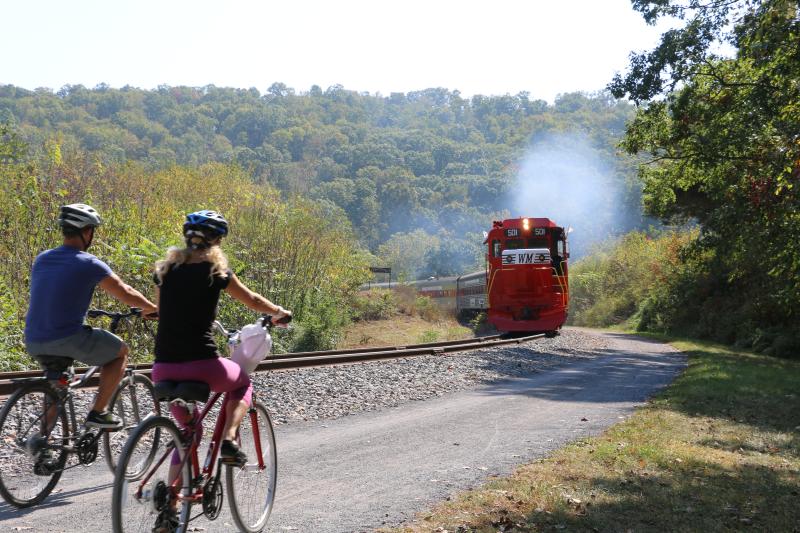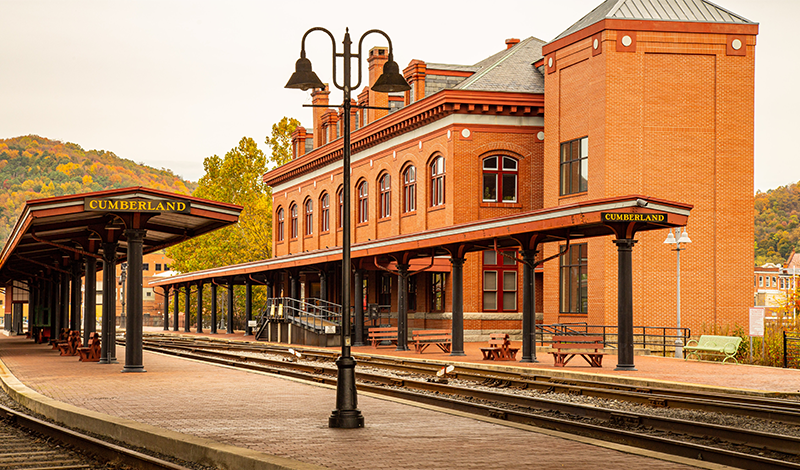The Great Allegheny Passage is a spectacular 150-mile, non-motorized, scenic rail trail stretching from mile zero in Cumberland, MD, to Pittsburgh PA, and is touted as one of USA Today’s 10Best Trails in North America. Find world-class accommodations along its many trail towns as you soar over valleys, snake around mountains, and skirt along the nearly-level, crushed-limestone path. But aside from the incredible care put in to the trail for hikers and bikers, there are many great historic, man-made, and natural features that urge further exploration, from ancient fossils, natural water-worn pathways, and historic landmarks. Check out these six recommendations of unique features as you make your way into Maryland towards Mile Marker "0" of the Great Allegheny Passage.
BIG SAVAGE OVERLOOK
MILE MARKER 22
Ok, so this one isn’t in Maryland, but it’s the first significant feature you encounter when you exit the Big Savage Tunnel and the first impression riders have of Mountain Maryland. This is a great resting point where you can see a beautiful rolling vista of mountain peaks from three different states - Pennsylvania, Maryland, and West Virginia.
MASON-DIXON LINE
MILE MARKER 22
Just a mile down the trail from the Big Savage Overlook is the Mason-Dixon Line Park. A replica obelisk and cast bronze marker plate and survey chain delineate the Mason-Dixon Line across the GAP trail, with two interpretive signs telling of how surveyors Charles Mason and Jeremiah Dixon settled a land dispute between Colonial Pennsylvania, Maryland, and Delaware. Later, the line was used to draw the boundary between the northern free states and the southern slave states. The park also includes 11 large granite blocks spelling Mason & Dixon, which serve as a great place to sit and rest after a long journey.

HELMSTETTER’S CURVE
MILE MARKER 5
One of the most famous railroad landmarks east of the Mississippi River, Helmstetter’s Curve is a 180-degree horseshoe curve along the abandoned Western Maryland Railway line. The line is still used today by the Western Maryland Scenic Railroad, which operates on the railroad line parallel to the GAP trail, and is a popular spot for photographers to capture the train in action.

BONE CAVE
MILE MARKER 4
The Great Allegheny Passage is an internationally recognized rail trail that follows the old Western Maryland Railway line from Cumberland to Frostburg. Cycle the route where you will find the Bone Cave. When the original rail line was constructed in 1912, a local naturalist discovered fossils among the rocks blasted from the site, prompting excavation by paleontologists from the Smithsonian Institution that same year who uncovered 41 genera of mammals, including a saber-toothed cat that is now on permanent exhibit in the Ice Age Mammal exhibit at the Smithsonian National Museum of Natural History in Washington, DC.

THE CUMBERLAND NARROWS
MILE MARKER 2
The Narrows offers a beautiful and unique landscape of the south side of Wills Mountain as you cycle through on the GAP trail. This natural water gap formed over thousands of years from a stream eroding through the sandstone surface, creating a 900-foot deep gorge and what is now known as Wills Creek. Due to its unique topography and natural passage through the Appalachian mountains, the route was part of a Native American footpath known as Nemacolin’s Trail, which later became instrumental for frontiersmen, military routes, and the development of transportation routes such as railways and the National Road.

CANAL PLACE HERITAGE PARK
Mile Marker 0
When you complete your journey along the Maryland portion of the Great Allegheny Passage, you will arrive at the Mile Marker 0 medallion in the Canal Place Heritage Park. The park is the heart of the Passages of the Western Potomac Heritage Area, Maryland’s first heritage area, and marks the terminus of the C&O Canal Towpath and the beginning of the GAP trail. Visitors can remark at the fully-restored, three-story Western Maryland Railway Station, ride the Western Maryland Scenic Railroad from Cumberland to Frostburg and back, tour a full-scale Canal Boat replica, learn about canal and transportation history through interpretive signage in the park, plus enjoy the shops at Canal Place.
